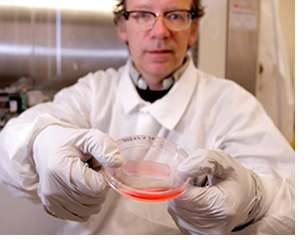Breast Implants Are Being Revolutionized Thanks to a Special 3D Printer

Print-your-own breast implants could be one of the new products in the $8.4 billion market of 3D printer products projected for 2025.
TeVido BioDevices is working to commercialize technology that would allow doctors to use a patient’s own fat to print a customized breast implant. The initial focus is reconstructive surgery after breast cancer, but the technology could also make plastic surgery cheaper and more successful.
Co-founder Laura Bosworth-Bucher said that the printer is similar to an inkjet many students use to print school papers, but modified to shoot out proteins instead of ink. The protein mixture is a composite of gelatin and alginate and it is printed onto specialized gel. An aluminum plate added to the printer’s paper feeding sensor and two switches along the y-axis of the machine help to evenly distribute the gelatin into the form.
Co-founder Thomas Boland, Ph.D. is the inventor of the technology and CTO for TeVido. He is also the Director of Biomedical Engineering at the University of Texas at El Paso (UTEP).
The company just won a Phase I SBIR grant for $150,000 and plans to apply for a Phase II grant in the summer.
“We highlighted the idea that ours could be a platform and picked a target market,” Bosworth-Bucher said. “Once we get this working, it could be used in a large portfolio of applications. We’re focusing on filling a small tumor void as our first product.”
The problem with current breast implants is fat volume retention.
“Fat gets reabsorbed when we want it to stay in place and be predictable,” Bosworth-Bucher said.
She said that the team is working to prove that this new fat implant will connect with the host and keep it alive. The current focus is tiny implants in mice.
“Next the work will be to expand the size capability and prove that it works over larger sizes,” Bosworth-Bucher said.


Leave a Reply
Want to join the discussion?Feel free to contribute!